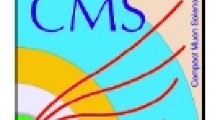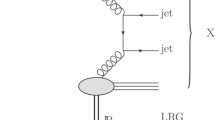Abstract
Two hard parton-parton interactions in a single proton-proton (pp) collison lead to double parton scattering (DPS). We investigate DPS in pp collisions at \(\sqrt{s}\) = 7 TeV where the final state includes a W boson, which decays into a muon and a neutrino, and two jets. Various observables sensitive to double parton scattering are investigated after being corrected for detector effects and selection efficiencies. The fraction of W + 2-jet events due to double parton scattering as well as the effective transverse area (\(\sigma _\mathrm{eff}\)) of the hard partonic interaction in the pp collision has been measured with the CMS experiment, using data collected at 7 TeV of center-of-mas energy corresponding to an integrated luminosity of 5 \(\mathrm fb^{-1}\). Studies for the invariance of \(\sigma _\mathrm{eff}\) with centre-of-mass energy, scale and different processes will also be presented in this talk, which are performed using the simulated events from Monte Carlo Event generator PYTHIA8.
This study was conducted on behalf of CMS collaboration.
Access provided by Autonomous University of Puebla. Download conference paper PDF
Similar content being viewed by others
Keywords
- Double Parton Scattering (DPS)
- Effective Transverse Area
- Hard Partonic Interaction
- Pythia
- Dijet Cross Section
These keywords were added by machine and not by the authors. This process is experimental and the keywords may be updated as the learning algorithm improves.
1 Introduction
The inelastic cross section is dominated by semi-hard parton-parton scattering in proton-proton (pp) collisions at high energy. The parton densities are large during such collisons with small values of x, where particles with transverse momenta \(\mathrm p_T\) of a few GeV are produced. It causes a sizable probability for two or more parton-parton scatterings within the same pp interaction [1]. In W + 2-jet process, the x values are larger with lower parton densities. But, a noticeable contribution to double parton scattering (DPS) is expected due to high rate of dijet production. The study of DPS processes provides information on the multi-parton correlations in the hadronic wave function [2] and on transverse distribution of partons in the proton [3]. DPS also constitutes as a major background for many physics searches [4–6].
A study of DPS based on W + 2-jet events in pp collisions at \(\sqrt{s}\) = 7 TeV is presented. DPS with a W + 2-jet final state occurs when one hard interaction produces a W boson and a dijet is produced from another hard interaction in the same pp collision, and W + 2-jet events originating from single parton scattering (SPS) constitute an irreducible background.
2 Effective Cross Section
The effective cross section, \(\sigma _\mathrm{eff}\), is a measure of the transverse distribution of partons inside the colliding hadrons and their overlap in a collision, which involves the cross section for two processes to occur simultaneously and the cross sections for the individual processes. If A and B are two independent processes, whose production cross sections are \(\sigma _{A}\) and \(\sigma _{B}\), respectively, \(\sigma _\mathrm{eff}\) can be written as:
where “m” is a symmetry factor for indistinguishable (\(m = 1\)) and distinguishable (\(m = 2\)) final-states and \(\sigma ^\mathrm{DPS}_{A+B}\) is the cross section of the two processes to occur simultaneously. As per simulated events from Pythia, the \(\sigma _\mathrm{eff}\) is found to be dependent on collision energy, but found independent of process as well as the scale of the two processes, which should be tested experimentally.
In the kinematic region of the present study, due to the requirement of having exactly 2 jets, the missing contribution of higher parton scatterings is found, using simulations, to be less than \(1\,\%\) of the DPS contribution.
The effective cross section, \(\sigma _\mathrm{eff}\) is reformulated as
where R is the ratio of the yield of W bosons associated with zero jets and the yield associated with DPS, \(\mathrm{R= N'_{W+0j} / N'_{W+2j}}\) and \(\sigma '_\mathrm{2j}\) is the particle-level cross section for W-boson production for dijet events . Thus, the determination of the effective cross section reduces to a measurement of R, \(\sigma '_\mathrm{2j}\), and \(\mathrm{f_{DPS}}\).
The DPS fraction, \(f_\mathrm{DPS}\), is extracted using the observables that can discriminate between SPS and DPS. For DPS events, the W and the dijet system are independent of each other, while for SPS events they are highly correlated. The present analysis uses the following observables:
-
the relative \(\mathrm p_T\)-balance between the two jets, \(\varDelta ^\mathrm{rel} \mathrm{p_T}\), defined as:
$$\begin{aligned} {{\varDelta }^\mathrm{rel}} {\mathrm{p}_\mathrm{T}} = \frac{ |{\mathrm{p}_\mathrm{T}}({\mathrm{j}_\mathrm{1}}) + {\mathrm{p}_\mathrm{T}}({\mathrm{j}_\mathrm{1}})| }{ |{\mathrm{p}_\mathrm{T}}({\mathrm{j}_\mathrm{1}})| + |{\mathrm{p}_\mathrm{T}}({\mathrm{j}_\mathrm{1}})| } \end{aligned}$$Here \({\mathrm{p}_\mathrm{T}}(\mathrm{j}_1)\) and \({\mathrm{p}_\mathrm{T}}(\mathrm{j}_2)\) are the transverse momentum vectors of the leading (in \({\mathrm{p}_\mathrm{T}}\)) and subleading jets. In DPS events, at leading order (LO), the two jets balance each other and \({\varDelta }^\mathrm{rel} {\mathrm{p}_\mathrm{T}}\) is small.
-
The azimuthal angle between the W-boson and the dijet system, \(\varDelta \mathrm{S}\), defined as:
$$\begin{aligned} \varDelta \mathrm{S} = \mathrm{arccos} \bigg ( \frac{{\mathrm{p}_\mathrm{T}}(\mu , \not \!\!{E_T})\cdot {\mathrm{p}_\mathrm{T}}(\mathrm{j}_\mathrm{1},{\mathrm{j}_2})}{|{\mathrm{p}_\mathrm{T}}(\mu , \not \!\!{E_T})|\cdot |{\mathrm{p}_\mathrm{T}}({\mathrm{j}_1,j_2})|} \bigg ), \end{aligned}$$where \({\mathrm{p}_\mathrm{T}}(\mu , \not \!\!{E_T})\) and \( {\mathrm{p}_\mathrm{T}}({\mathrm{j}_{1},j_{2}})\) are the combined transverse momentum vectors of \((\mu , \not \!\!{E_T})\) and the two jets, respectively, with \(\not \!\!{E_T}\) as the missing transverse energy in the event, which is a measure of the transverse energy carried away by the neutrino from the W-boson decay. In DPS events, the W and dijet momentum vectors are randomly oriented, whereas in SPS events the W and the dijet momenta vectors tend to be back-to-back at LO.
3 Unfolding and Comparison with Simulations
The sample of W + 2-jet events is selected and the contributions of all backgrounds are subtracted from the data distributions before unfolding. The distributions of the DPS-sensitive observables are corrected for selection efficiencies and detector effects. The measured distributions are unfolded to the level of stable particles within the phase space mentioned in Table 23.1.
Various simulations at particle level are compared with the fully corrected DPS-sensitive observables:
-
MadGraph 5 + Pythia 8: W + jets events are generated by means of MadGraph 5 followed by hadronization and parton showering using the 4 C tune of Pythia 8. The MPI are simulated with the Pythia 8 event generator.
-
Powheg 2 + Pythia 6: W + 2-jet events are also produced up to NLO accuracy with the Powheg 2 event generator with the"Multi-scale improved NLO” (MiNLO) method. Hadronization and parton showering is carried out with Pythia 6 tune Z2*.
-
Pythia 8: W + jets events are generated with the 4 C tune of the Pythia 8 event generator, which produces hard subprocesses with a W boson and either zero or one additional parton in the final state.
A comparison of various simulations for inclusive W production with the corrected distributions is shown in Fig. 23.1. The \(\varDelta ^\mathrm{rel} \mathrm{p_T}\) and \(\varDelta \mathrm{S}\) distributions are properly described by MadGraph 5 + Pythia 8 and the NLO predictions from Powheg 2 + Pythia 6. The Pythia 8 simulation underestimates the measurements due to the fact that Pythia 8 generates only \(2 \rightarrow 1\) and \(2 \rightarrow 2\) processes and most of the additional jets are produced during parton showering, and have a softer \(\mathrm{p_T}\) spectrum. Therefore, event generators used to define SPS backgrounds must include a proper implementation of additional hard radiation. If it is not included, the effect of missing hard radiation might be interpreted as a DPS contribution. MadGraph 5 + Pythia 8 and Powheg 2 + Pythia 6 predictions without MPI are unable to describe the data shown in Fig. 23.1.
4 Determination of the Effective Cross Section
As discussed in Sect. 23.2 to calculate the effective cross section the measurements of DPS fraction, the measurements of the dijet cross section and R are necessary.
The fraction of W + 2-jet events produced by DPS is extracted by performing a template fit using the signal and background templates to the fully corrected distributions of \(\varDelta ^\mathrm{rel} \mathrm{p_T}\) and \(\varDelta \mathrm{S}\). The signal template is obtained by randomly mixing independently produced W and dijet events, whereas the background template is produced from the W + 2-jet sample simulated with MadGraph 5 + Pythia 8, in which events with MPI-tagged partons within the acceptance (\(\mathrm{|\eta | < 2}\)) are removed.
The measured values of the DPS fraction (\(\mathrm{f_\mathrm{DPS}}\)), ratio (R) and dijet cross section (\(\sigma ^{'}_\mathrm{2j}\)) are given in Table 23.2 along with the calculated value of the effective cross section (\(\sigma _\mathrm{eff}\)).
5 Summary
A study of DPS based on W + 2-jet events in pp collisions at \(\sqrt{s}\) = 7 TeV is presented. The fraction of W + 2-jet events due to DPS as well as effective cross section is measured in CMS experiment, using data collected at 7 TeV of center-of-mass energy corresponding to an integrated luminosity of 5 \(\mathrm{fb^{-1}}\). Figure 23.2 shows a comparison of the effective cross sections obtained using different processes at various centre-of-mass energies. From the experimental results, a firm conclusion on the energy dependence of \(\sigma _\mathrm{eff}\) cannot be drawn because of the large systematic uncertainties. The CMS measurement is consistent with previous measurements performed at the Tevatron and by the ATLAS Collaboration at the LHC. The CMS measurement is also consistent with predictions from Pythia of \(\mathrm{20}\)–\(\mathrm{30}\) mb, depending on the tune.
References
T. Sjöstrand, M. Van Zijl, A multiple interaction model for the event structure in hadron collisions. Phys. Rev. D 36, 2019 (1987). doi:10.1103/PhysRevD.36.2019
G. Calucci, D. Treleani, Disentangling correlations in multiple parton interactions. Phys. Rev. D 83, 016012 (2011). doi:10.1103/PhysRevD.83.016012. arXiv:1009.5881
M. Diehl, D. Ostermeier, A. Schäfer, Elements of a theory for multiparton interactions in QCD. JHEP 03, 89 (2012). doi:10.1007/JHEP03(2012)089. arXiv:1111.0910
A.D. Fabbro, D. Treleani, A double parton scattering background to Higgs boson production at the LHC. Phys. Rev. D 61, 077502 (2000). doi:10.1103/PhysRevD.61.077502. arXiv:hep-ph/9911358
M.Y. Hussein, A double parton scattering background to associate WH and ZH production at the LHC. Nucl. Phys. Proc. Suppl. 174, 55 (2007). doi:10.1016/j.nuclphysbps.2007.08.086. arXiv:hep-ph/0610207
D. Bandurin, G. Golovanov, N. Skachkov, Double parton interactions as a background to associated HW production at the Tevatron. JHEP 04, 054 (2011). doi:10.1007/JHEP04(2011)054. arXiv:1011.2186
Author information
Authors and Affiliations
Corresponding author
Editor information
Editors and Affiliations
Rights and permissions
Copyright information
© 2016 Springer International Publishing Switzerland
About this paper
Cite this paper
Kumar, R., Bansal, S., Bansal, M., Bhatnagar, V., Mazumdar, K., Singh, J.B. (2016). Study of the Double Parton Scattering via W + 2-Jet Process Using the CMS Detector at LHC. In: Bhuyan, B. (eds) XXI DAE-BRNS High Energy Physics Symposium. Springer Proceedings in Physics, vol 174. Springer, Cham. https://doi.org/10.1007/978-3-319-25619-1_23
Download citation
DOI: https://doi.org/10.1007/978-3-319-25619-1_23
Published:
Publisher Name: Springer, Cham
Print ISBN: 978-3-319-25617-7
Online ISBN: 978-3-319-25619-1
eBook Packages: Physics and AstronomyPhysics and Astronomy (R0)






